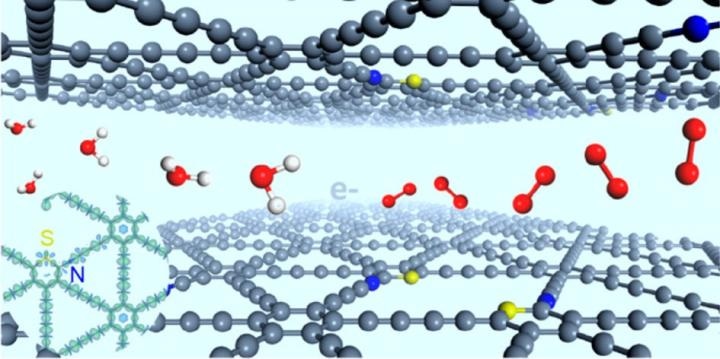May 2 2019
In energy-related methods, like water splitting and metal-air batteries, the oxygen evolution reaction, or OER in short, is highly significant.
 Stereo-defined sp-N and S atoms for efficient oxygen evolution (Image credit: ZHAO Yasong)
Stereo-defined sp-N and S atoms for efficient oxygen evolution (Image credit: ZHAO Yasong)
Now, researchers in China have doped site-defined S and sp-N atoms into graphdiyne, which facilitates highly active catalysis of OER. The results of the study have been reported in J. Am. Chem. Soc.
Conventional OER catalysts, for example, IrO2 and RuO2 are restricted by reducing stability and high cost. Carbon materials doped with heteroatoms, particularly dual doping materials, have shown interesting an capability for highly efficient electrocatalysis because of the synergistic effect. Conversely, the doping sites for varied atoms are extremely uncontrollable, making it difficult to study the structural properties.
This synergistic effect can occur only within a specific distance between the dual atoms, and a robust synergistic effect can be achieved only if the upper limit for S and N atoms is 0.75 Å.
Now, at the Institute of Process Engineering (IPE) of the Chinese Academy of Sciences, researchers have effectively prepared “stereodefined” S and N atom-codoped graphdiyne, and the corresponding positions of the S and N atoms were suitably controlled.
N-, S-codoped graphdiyne presented higher catalytic activity than those catalysts with individual-element doping (N or S atom) and commercial RuO2 in catalyzing the OER, possessing lower overpotential (299 mV) and higher current density (47.2 mA/cm2, 1.6 V).
WANG Dan, Study Lead and PhD, Chinese Academy of Sciences
The latest research provides an opportunity for gaining a deeper insight into the synergistic effects in catalysts that are doped with heteroelements and free of metals, and for further guiding the practical design and development of highly efficient catalysts for conversion and storage of energy.